Layout:
Showing 251-258 of 258
-
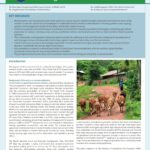 NAFRI Research Brief: Leveraging Geo-Economic Proximity and Agricultural Commercialisation
Title of document: NAFRI Research Brief: Leveraging Geo-Economic Proximity and Agricultural Commercialisation Authors/editor: Mr. Khamphou Phouyyavong, (PhD), Deputy Director of ERDRC, NAFRI; Ms. Isabelle Vagneron (PhD), Policy Research Specialist; Ms. Sengphachanh Sonethavixay, Technical Advisor; Mr. Anthony M. Zola, Development Economist Journal’s name if any: Ministry/Government Agency/Organization: NAFRI - MAF Year of publication: 2020 Geographic focus: Lao PDR Main issues/ topics addressed (for example: …) School of agroecology (if any): Web address to original document (if any): Summary: The purpose of this research brief is to synthesize the findings of ten policy research studies conducted by NAFRI’s Policy Think Tank (PTT) research team between 2016 and 2020, and complementary research studies. The research was related to commercialisation of agricultural products in Lao PDR… Read MoreALiSEA teams 15 downloads
NAFRI Research Brief: Leveraging Geo-Economic Proximity and Agricultural Commercialisation
Title of document: NAFRI Research Brief: Leveraging Geo-Economic Proximity and Agricultural Commercialisation Authors/editor: Mr. Khamphou Phouyyavong, (PhD), Deputy Director of ERDRC, NAFRI; Ms. Isabelle Vagneron (PhD), Policy Research Specialist; Ms. Sengphachanh Sonethavixay, Technical Advisor; Mr. Anthony M. Zola, Development Economist Journal’s name if any: Ministry/Government Agency/Organization: NAFRI - MAF Year of publication: 2020 Geographic focus: Lao PDR Main issues/ topics addressed (for example: …) School of agroecology (if any): Web address to original document (if any): Summary: The purpose of this research brief is to synthesize the findings of ten policy research studies conducted by NAFRI’s Policy Think Tank (PTT) research team between 2016 and 2020, and complementary research studies. The research was related to commercialisation of agricultural products in Lao PDR… Read MoreALiSEA teams 15 downloads -
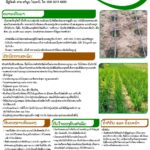 The poster presents the results of various activities of the Lao Farmer Network (Lao language)
Title of document: The poster presents the results of various activities of the Lao Farmer Network (Lao language) Authors/editor: LFN Journal’s name if any: Ministry/Government Agency/Organization: LFN, DEAC Year of publication: 2023 Geographic focus: Laos Main issues/ topics addressed (for example: a posters of partners organizations and farmer representatives to shared their experience on various of topics such as organic fertilizer business of Thakhor group, spring onion seed business, a new rice farming system, integrated pest control, producer public private sector partnership development, agriculture innovation competition scheme, etc…) School of agroecology (if any): Web address to original document (if any): Summary: The posters were shared in the Lao Farmer Network General Assembly on Febuary 1, 2023 that including lessons on organic fertilizer business of Thakhor group, spring onion seed business, a new rice farming system, integrated pest control, producer public private sector partnership development, agriculture innovation competition scheme, etc. Full article about LFN’s general assembly here Read MoreALiSEA teams 8 downloads
The poster presents the results of various activities of the Lao Farmer Network (Lao language)
Title of document: The poster presents the results of various activities of the Lao Farmer Network (Lao language) Authors/editor: LFN Journal’s name if any: Ministry/Government Agency/Organization: LFN, DEAC Year of publication: 2023 Geographic focus: Laos Main issues/ topics addressed (for example: a posters of partners organizations and farmer representatives to shared their experience on various of topics such as organic fertilizer business of Thakhor group, spring onion seed business, a new rice farming system, integrated pest control, producer public private sector partnership development, agriculture innovation competition scheme, etc…) School of agroecology (if any): Web address to original document (if any): Summary: The posters were shared in the Lao Farmer Network General Assembly on Febuary 1, 2023 that including lessons on organic fertilizer business of Thakhor group, spring onion seed business, a new rice farming system, integrated pest control, producer public private sector partnership development, agriculture innovation competition scheme, etc. Full article about LFN’s general assembly here Read MoreALiSEA teams 8 downloads -
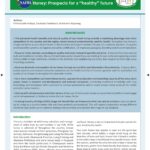 Learning Brief- Marketing potential of Lao Forest Honey: Prospects for a “healthy” future_ English & Lao version
Title of document: Learning Brief- Marketing potential of Lao Forest Honey: Prospects for a “healthy” future_ English & Lao version Authors/editor: Emmanuelle Andaya, Soutsada Chanthasiri, Manivanh Aliyavong Journal’s name if any: Ministry/Government Agency/Organization: NAFRI, TABI, NUoL, GCDA, DECA, NTFP-EP Year of publication: 2018 Geographic focus: Lao PDR Main issues/ topics addressed (for example:…) School of agroecology (if any): Web address to original document (if any): Summary: NAFRI learning Brief: The perceived health benefits and natural quality of Lao Forest Honey provide a marketing advantage over other competitors in the country and the region, where honey is predominantly used for health. Strengthen Lao Honey’s image and brand as pure forest honey in the domestic and export markets through (1) a national standard, (2) quality and traceability systems, (3) hygiene and safety certification, (3) improved packaging, branding, and (4) communication. Focus on niche markets, competing on quality and value instead of quantity and price. Instead of the international bulk and traditional markets, the Lao Forest honey sector should focus on creating its own niche and capturing a share of the middle to high-end honey markets in the domestic and neighboring countries, and then expand to other high-value import ng countries. Increase domestic c consumption of Lao honey through accessibility and information dissemination. Improve distribution on systems and increase consumer awareness of the health benefits of honey in general, and the availability and quality of Lao honey to strengthen the domestic market. For a more competitive Lao Forest Honey Sector, upgrade the product and marketing capacity of the value chain actors, invest in research and development, and promote innovation. Combining traditional knowledge with new technology and techniques offers the potential to increase productivity and create unique honey products for health and other niche markets. Link up with entrepreneurs and other sectors. Make use of the tourism sector as a promoter on a platform and engage social entrepreneurs to further promote the Lao Honey Sector. A strong Country of Origin (COO) image will benefit the Lao Honey and other Lao natural products. Laos can develop its image as a country where safe and clean products are produced. This will require cooperation among different ministries and sectors and a national strategy that promotes and protects the image of Lao products. Read MoreALiSEA teams 5 downloads
Learning Brief- Marketing potential of Lao Forest Honey: Prospects for a “healthy” future_ English & Lao version
Title of document: Learning Brief- Marketing potential of Lao Forest Honey: Prospects for a “healthy” future_ English & Lao version Authors/editor: Emmanuelle Andaya, Soutsada Chanthasiri, Manivanh Aliyavong Journal’s name if any: Ministry/Government Agency/Organization: NAFRI, TABI, NUoL, GCDA, DECA, NTFP-EP Year of publication: 2018 Geographic focus: Lao PDR Main issues/ topics addressed (for example:…) School of agroecology (if any): Web address to original document (if any): Summary: NAFRI learning Brief: The perceived health benefits and natural quality of Lao Forest Honey provide a marketing advantage over other competitors in the country and the region, where honey is predominantly used for health. Strengthen Lao Honey’s image and brand as pure forest honey in the domestic and export markets through (1) a national standard, (2) quality and traceability systems, (3) hygiene and safety certification, (3) improved packaging, branding, and (4) communication. Focus on niche markets, competing on quality and value instead of quantity and price. Instead of the international bulk and traditional markets, the Lao Forest honey sector should focus on creating its own niche and capturing a share of the middle to high-end honey markets in the domestic and neighboring countries, and then expand to other high-value import ng countries. Increase domestic c consumption of Lao honey through accessibility and information dissemination. Improve distribution on systems and increase consumer awareness of the health benefits of honey in general, and the availability and quality of Lao honey to strengthen the domestic market. For a more competitive Lao Forest Honey Sector, upgrade the product and marketing capacity of the value chain actors, invest in research and development, and promote innovation. Combining traditional knowledge with new technology and techniques offers the potential to increase productivity and create unique honey products for health and other niche markets. Link up with entrepreneurs and other sectors. Make use of the tourism sector as a promoter on a platform and engage social entrepreneurs to further promote the Lao Honey Sector. A strong Country of Origin (COO) image will benefit the Lao Honey and other Lao natural products. Laos can develop its image as a country where safe and clean products are produced. This will require cooperation among different ministries and sectors and a national strategy that promotes and protects the image of Lao products. Read MoreALiSEA teams 5 downloads -
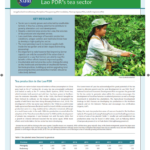 NAFRI Policy Brief - Unlocking the full potential of Lao PDR’s tea sector_English & Lao version
Title of document: NAFRI Policy Brief - Unlocking the full potential of Lao PDR’s tea sector_English & Lao version Authors/editor: Sengphachanh Sonethavixay, Khamphou Phouyyavong (PhD Candidate), Phanxay Ingxay (PhD), Isabelle Vagneron (PhD) Journal’s name if any: Ministry/Government Agency/Organization: NAFRI Year of publication: 2018 Geographic focus: Lao PDR Main issues/ topics addressed (for example:…) School of agroecology (if any): Web address to original document (if any): Summary: Policy Brief No. 001/2018: Tea in Laos is mainly grown and collected by smallholder farmers. It thus has a strong potential to contribute to poverty alleviation and rural development. Despite a relatively large production area, the volumes of tea produced and exported are low. Laos could take advantage of favorable production conditions, unique varieties and traditional know-how to develop a high-quality tea sector. The most pressing issue is to improve quality both inside the tea garden and at later stages (harvesting, processing). It is important to note however that improving farmer capacity can only be successful if the value-chain is organized in a way that farmers are able to reap the benefi ts of their eff orts towards improved quality. A sustainable and inclusive tea sector strategy focusing on the livelihoods and benefi ts of smallholder farmers, fair trade practices, building up and/or upgrading local processing facilities and diversifi ed markets should be collectively defi ned. Read MoreALiSEA teams 5 downloads
NAFRI Policy Brief - Unlocking the full potential of Lao PDR’s tea sector_English & Lao version
Title of document: NAFRI Policy Brief - Unlocking the full potential of Lao PDR’s tea sector_English & Lao version Authors/editor: Sengphachanh Sonethavixay, Khamphou Phouyyavong (PhD Candidate), Phanxay Ingxay (PhD), Isabelle Vagneron (PhD) Journal’s name if any: Ministry/Government Agency/Organization: NAFRI Year of publication: 2018 Geographic focus: Lao PDR Main issues/ topics addressed (for example:…) School of agroecology (if any): Web address to original document (if any): Summary: Policy Brief No. 001/2018: Tea in Laos is mainly grown and collected by smallholder farmers. It thus has a strong potential to contribute to poverty alleviation and rural development. Despite a relatively large production area, the volumes of tea produced and exported are low. Laos could take advantage of favorable production conditions, unique varieties and traditional know-how to develop a high-quality tea sector. The most pressing issue is to improve quality both inside the tea garden and at later stages (harvesting, processing). It is important to note however that improving farmer capacity can only be successful if the value-chain is organized in a way that farmers are able to reap the benefi ts of their eff orts towards improved quality. A sustainable and inclusive tea sector strategy focusing on the livelihoods and benefi ts of smallholder farmers, fair trade practices, building up and/or upgrading local processing facilities and diversifi ed markets should be collectively defi ned. Read MoreALiSEA teams 5 downloads -
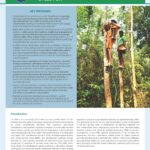 NAFRI research Brief - Negotiating the Forest-Fallow Interface: Benzoin Tree in the Multifunctional Landscapes of Lao PDR
Title of document: NAFRI research Brief - Negotiating the Forest-Fallow Interface: Benzoin Tree in the Multifunctional Landscapes of Lao PDR Authors/editor: TABI Journal’s name if any: Ministry/Government Agency/Organization: NAFRI, TABI Year of publication: 2019 Geographic focus: Lao PDR Main issues/ topics addressed (for example:…) School of agroecology (if any): Web address to original document (if any): Summary: Research Brief No. 001/2019: Upland agriculture systems are under threat from competing land uses and development priorities that seek to intensify agricultural land uses while promoting strict forest conservation, leading to shortened fallow systems and a large-scale shift toward commodity crop production Better alternatives are needed for the development of Lao PDR’s uplands—alternatives that build on traditional management regimes, local agrobiodiversity and traditional knowledge systems rather than replace them, recognizing multiple uses of landscape systems and their substantial potential to contribute to sustainable socioeconomic development. Multifunctional landscapes depend on a complex mixture of croplands, forest, fallows and the diversity of endemic species used by local communities. Long-fallow rotational systems are a key element in these complex uplands, enhancing and supporting ecosystems services and the sustainability of upland systems Benzoin tree is exemplary of similar local species adapted to long-rotational cultivation systems and an integral part of upland diversity. Benzoin depends on long-fallowing and enhances economic returns from upland systems. Despite strong market demand and rising prices, Benzoin production has decreased dramatically in recent years due to shortening rotations and loss of available land due to forest conservation measures and the rapid expansion of commercial crops. Analysis indicates that for economic returns and production per unit of land and labour, benzoin production compares favourably with typical cash crop alternatives such as maize, while also delivering co-benefits for sustainability. Benzoin production represents an agro-forestry system with high sustainability. Benzoin should be regarded as an agricultural product, rather than a natural product with regard to quota systems and taxation. Read MoreALiSEA teams 2 downloads
NAFRI research Brief - Negotiating the Forest-Fallow Interface: Benzoin Tree in the Multifunctional Landscapes of Lao PDR
Title of document: NAFRI research Brief - Negotiating the Forest-Fallow Interface: Benzoin Tree in the Multifunctional Landscapes of Lao PDR Authors/editor: TABI Journal’s name if any: Ministry/Government Agency/Organization: NAFRI, TABI Year of publication: 2019 Geographic focus: Lao PDR Main issues/ topics addressed (for example:…) School of agroecology (if any): Web address to original document (if any): Summary: Research Brief No. 001/2019: Upland agriculture systems are under threat from competing land uses and development priorities that seek to intensify agricultural land uses while promoting strict forest conservation, leading to shortened fallow systems and a large-scale shift toward commodity crop production Better alternatives are needed for the development of Lao PDR’s uplands—alternatives that build on traditional management regimes, local agrobiodiversity and traditional knowledge systems rather than replace them, recognizing multiple uses of landscape systems and their substantial potential to contribute to sustainable socioeconomic development. Multifunctional landscapes depend on a complex mixture of croplands, forest, fallows and the diversity of endemic species used by local communities. Long-fallow rotational systems are a key element in these complex uplands, enhancing and supporting ecosystems services and the sustainability of upland systems Benzoin tree is exemplary of similar local species adapted to long-rotational cultivation systems and an integral part of upland diversity. Benzoin depends on long-fallowing and enhances economic returns from upland systems. Despite strong market demand and rising prices, Benzoin production has decreased dramatically in recent years due to shortening rotations and loss of available land due to forest conservation measures and the rapid expansion of commercial crops. Analysis indicates that for economic returns and production per unit of land and labour, benzoin production compares favourably with typical cash crop alternatives such as maize, while also delivering co-benefits for sustainability. Benzoin production represents an agro-forestry system with high sustainability. Benzoin should be regarded as an agricultural product, rather than a natural product with regard to quota systems and taxation. Read MoreALiSEA teams 2 downloads -
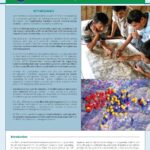 NAFRI research Brief - New Directions for Participatory Land Use Planning: Can Bottom-up Approaches Achieve a Win-Win for Sustainable Development and Forest Conservation?
Title of document: NAFRI research Brief - New Directions for Participatory Land Use Planning: Can Bottom-up Approaches Achieve a Win-Win for Sustainable Development and Forest Conservation? Authors/editor: TABI Journal’s name if any: Ministry/Government Agency/Organization: NAFRI, DALaM, TABI Year of publication: 2019 Geographic focus: Lao PDR Main issues/ topics addressed (for example:…) School of agroecology (if any): Web address to original document (if any): Summary: Research Brief No. 002/2019: Land-intensive development pathways such as TLIC and the expansion of commercial agriculture are placing increased demand on rural landscapes and heightening tensions around resource-tenure security, requiring innovative approaches to planning. National development and conservation goals are sometimes, but not always, compatible with one another and with the needs and interest of local communities, requiring mechanisms for negotiation. Top-down planning tools provide a general framework for enhancing synergies and negotiating trade-offs between development and conservation goals at the macro-level, but bottom-up processes are necessary to ensure local needs and enable village-level planning and management. An innovative, bottom-up participatory land use planning approach co-developed and implemented by a consortium of GoL agencies, development practitioners and researchers through the Agro-biodiversity Initiative (TABI) demonstrates strong potential for supporting national development and conservation goals in a manner that is locally-acceptable and reflects actual land uses and resource needs. Through the participatory Forest and Land Use Planning and Management (pFALUPAM) approach, areas allocated for forests increased by 8.4 percent, though varied significantly by area depending on local contextual factors. Collaborative planning supported enhanced landscape-scale connectivity between forest areas, promoting ecosystem service values. Agrobiodiversity and the integrity of multifunctional landscapes were enhanced through zonation for local species and cultivars, protection of agricultural areas, and the promotion of long-fallowing in rotational upland systems through colocation. The pFALUPAM approach facilitated local management by clarifying inter-village boundaries to reduce conflict, enhancing local tenure security, and providing a mechanism for community consensus-building around management objectives. Further work is needed to support local institutions and capacities for adaptive management and the clarification of jap jong ti din1 and its effects on communally-managed resources. Read MoreALiSEA teams 6 downloads
NAFRI research Brief - New Directions for Participatory Land Use Planning: Can Bottom-up Approaches Achieve a Win-Win for Sustainable Development and Forest Conservation?
Title of document: NAFRI research Brief - New Directions for Participatory Land Use Planning: Can Bottom-up Approaches Achieve a Win-Win for Sustainable Development and Forest Conservation? Authors/editor: TABI Journal’s name if any: Ministry/Government Agency/Organization: NAFRI, DALaM, TABI Year of publication: 2019 Geographic focus: Lao PDR Main issues/ topics addressed (for example:…) School of agroecology (if any): Web address to original document (if any): Summary: Research Brief No. 002/2019: Land-intensive development pathways such as TLIC and the expansion of commercial agriculture are placing increased demand on rural landscapes and heightening tensions around resource-tenure security, requiring innovative approaches to planning. National development and conservation goals are sometimes, but not always, compatible with one another and with the needs and interest of local communities, requiring mechanisms for negotiation. Top-down planning tools provide a general framework for enhancing synergies and negotiating trade-offs between development and conservation goals at the macro-level, but bottom-up processes are necessary to ensure local needs and enable village-level planning and management. An innovative, bottom-up participatory land use planning approach co-developed and implemented by a consortium of GoL agencies, development practitioners and researchers through the Agro-biodiversity Initiative (TABI) demonstrates strong potential for supporting national development and conservation goals in a manner that is locally-acceptable and reflects actual land uses and resource needs. Through the participatory Forest and Land Use Planning and Management (pFALUPAM) approach, areas allocated for forests increased by 8.4 percent, though varied significantly by area depending on local contextual factors. Collaborative planning supported enhanced landscape-scale connectivity between forest areas, promoting ecosystem service values. Agrobiodiversity and the integrity of multifunctional landscapes were enhanced through zonation for local species and cultivars, protection of agricultural areas, and the promotion of long-fallowing in rotational upland systems through colocation. The pFALUPAM approach facilitated local management by clarifying inter-village boundaries to reduce conflict, enhancing local tenure security, and providing a mechanism for community consensus-building around management objectives. Further work is needed to support local institutions and capacities for adaptive management and the clarification of jap jong ti din1 and its effects on communally-managed resources. Read MoreALiSEA teams 6 downloads -
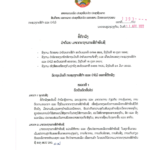 Agreement of the Minister on Organic Agriculture Standards in Lao PDR [Lao Version]
Title of document: Agreement of the Minister on Organic Agriculture Standards in Lao PDR [Lao Version] Authors/editor: DOA Journal’s name if any: Ministry/Government Agency/Organization: MAF Year of publication: 2022 Geographic focus: Lao PDR Main issues/ topics addressed (for example: new agreement of the Minister on Organic Agriculture Standards) School of agroecology (if any): Web address to original document (if any): Summary: New agreement of the Ministry of Agriculture and Forestry on Organic Agriculture Standards, No. 1393/MAF, date 11 April 2022. Read MoreALiSEA teams 11 downloads
Agreement of the Minister on Organic Agriculture Standards in Lao PDR [Lao Version]
Title of document: Agreement of the Minister on Organic Agriculture Standards in Lao PDR [Lao Version] Authors/editor: DOA Journal’s name if any: Ministry/Government Agency/Organization: MAF Year of publication: 2022 Geographic focus: Lao PDR Main issues/ topics addressed (for example: new agreement of the Minister on Organic Agriculture Standards) School of agroecology (if any): Web address to original document (if any): Summary: New agreement of the Ministry of Agriculture and Forestry on Organic Agriculture Standards, No. 1393/MAF, date 11 April 2022. Read MoreALiSEA teams 11 downloads -
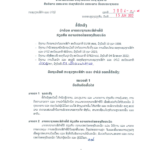 Agreement of the Minister on Good Agriculture Practices for Agriculture Products Standard in Lao PDR [Lao Version]
Title of document: Agreement of the Minister on Good Agriculture Practices for Agriculture Products Standard in Lao PDR [Lao Version] Authors/editor: DOA Journal’s name if any: Ministry/Government Agency/Organization: MAF Year of publication: 2022 Geographic focus: Lao PDR Main issues/ topics addressed (for example: New Agreement of the Minister on Good Agriculture Practices for Agriculture Products Standard in Lao PDR) School of agroecology (if any): Web address to original document (if any): Summary: New agreement of the Ministry of Agriculture and Forestry on Good Agriculture Practices for Agriculture Products Standard in Lao PDR, No. 3004/MAF, date 15 June 2022. Read MoreALiSEA teams 8 downloads
Agreement of the Minister on Good Agriculture Practices for Agriculture Products Standard in Lao PDR [Lao Version]
Title of document: Agreement of the Minister on Good Agriculture Practices for Agriculture Products Standard in Lao PDR [Lao Version] Authors/editor: DOA Journal’s name if any: Ministry/Government Agency/Organization: MAF Year of publication: 2022 Geographic focus: Lao PDR Main issues/ topics addressed (for example: New Agreement of the Minister on Good Agriculture Practices for Agriculture Products Standard in Lao PDR) School of agroecology (if any): Web address to original document (if any): Summary: New agreement of the Ministry of Agriculture and Forestry on Good Agriculture Practices for Agriculture Products Standard in Lao PDR, No. 3004/MAF, date 15 June 2022. Read MoreALiSEA teams 8 downloads

 Asia & Mekong Region
Asia & Mekong Region  Cambodia
Cambodia  Laos
Laos  Myanmar
Myanmar  Other
Other  Vietnam
Vietnam